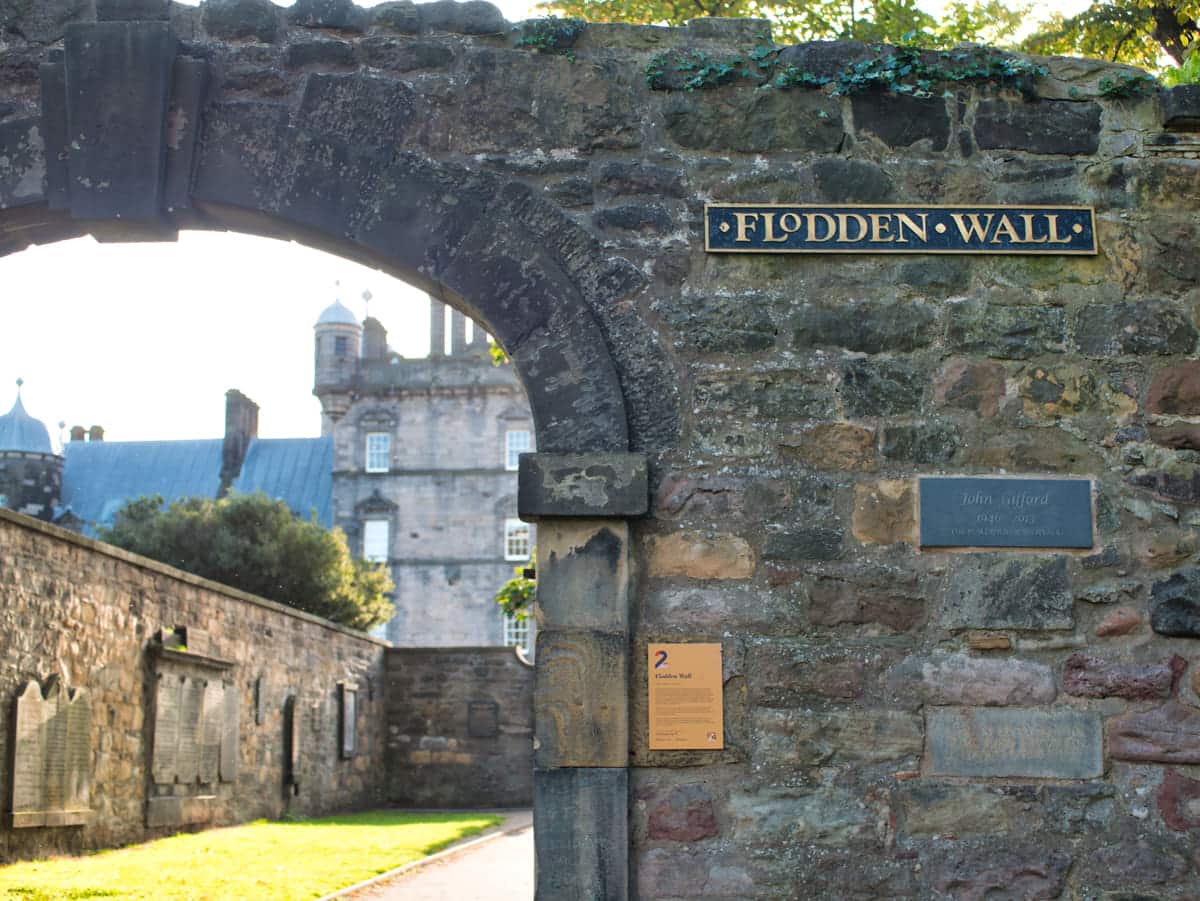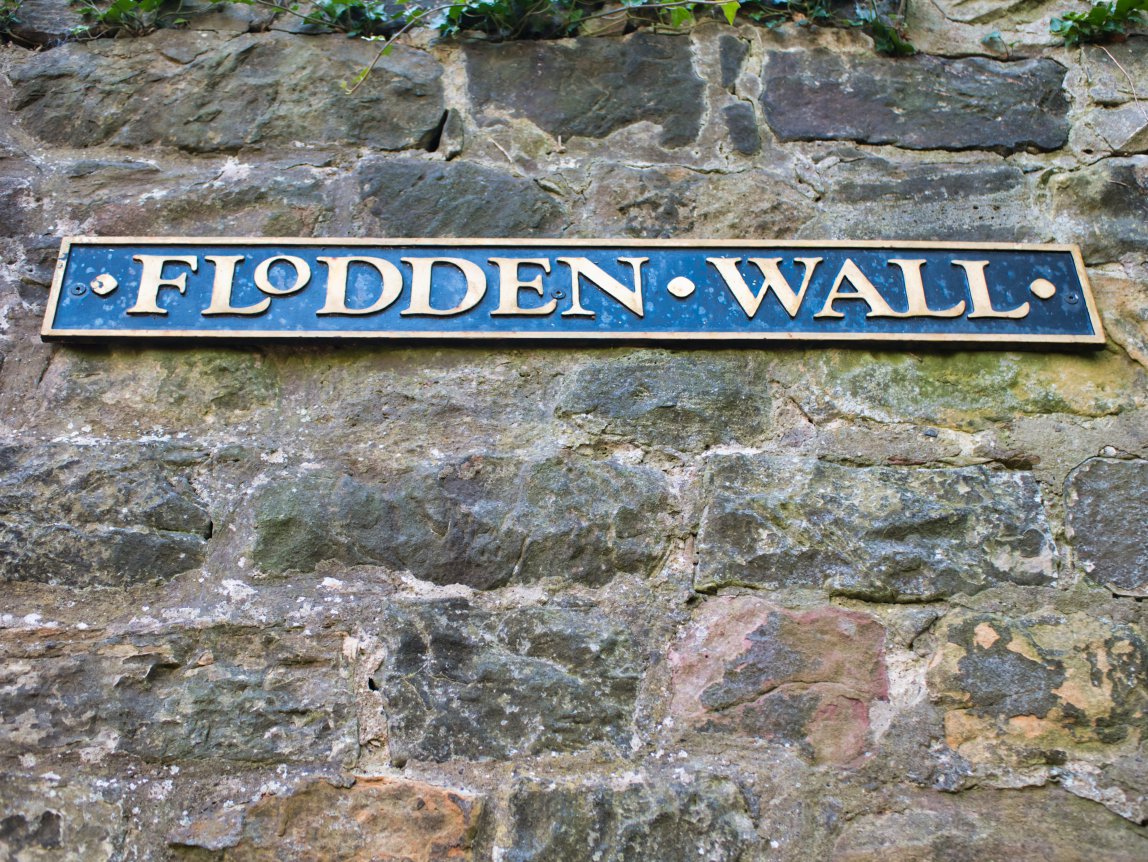Edinburgh’s Flodden Wall is a historic defensive structure that was built in the early 16th century. Work began on it after the disastrous 1513 Battle of Flodden when the English army defeated the Scots, and the wall was built to protect the city from any potential invasions.
Although it’s no longer complete, several parts of the wall still exist today and can be seen in various parts of Edinburgh, including the Pleasance and the Grassmarket. The Flodden Wall is a fascinating piece of Scotland’s history and is well worth seeking out if you’re touring the capital city.

Overview
As you walk around the ancient city of Edinburgh you might notice several sections of fortified wall that seem slightly out of place in relation to the other buildings that stand alongside them. These walls are the remains of an immense fortification that at one time encircled the entirety of Edinburgh’s Old Town.
The Flodden Wall was built in 1560 as a defensive measure against an English invasion, completely surrounding an area over 140 acres in size. Incredibly, around 10,000 people lived within the confines of the wall, all of whom could only leave by paying a hefty tax at one of six exit gates. The wall continued to protect (and confine) Edinburgh’s residents until the 18th century when it began to fall into ruin, and it was eventually almost entirely built over as the city expanded.
One of the most intact sections of the wall can be seen at the far south-western end of The Grassmarket in a narrow close called The Vennel, beyond which is the Telfer Wall, a later extension that continues to Lauriston Place. These locations are easy to find if you follow Google Maps and take a walk to The Grassmarket which is a few minute’s walk from Edinburgh Castle.

The Highlights
1: The wall is a remarkable example of medieval architecture. Despite significant sections being lost over time, parts of the wall that remain intact showcase the traditional stone masonry techniques of the era. Key surviving sections include the stretch near the Pleasance and the Drummond Street area.
2: The Flodden Wall holds immense historical value. Built in the 16th century, it was constructed as a defensive boundary and was an integral part of Edinburgh’s safety. It’s now an architectural oddity that offers a glimpse into the city’s past.
Visiting Tips
1: One of the best places to see the wall is at Greyfriars Kirk, so combine a visit together with the kirk and wee Bobby’s grave.
2: The National Museum of Scotland is opposite Greyfriars which is filled to the brim with historic artefacts. The museum is free to visit so it’s worth visiting for any history buff touring Edinburgh.
3: Other sections of the wall can be found along The Vennel leading to the Grassmarket, and running down Drummond Street to the Pleasance. If you’re not sure where to go, enter those names into Google Maps.

Tourist Information
While some guided tours will take you around all the remaining sections of the Flodden Wall, the best way to see it (in my opinion) is to grab a tourist guidebook and walk around the streets of Edinburgh on your own.
If you keep a watchful eye out you might see several brass cobblestones embedded into Edinburgh’s streets which mark the boundaries where the original wall once stood. They’re a wee bit tricky to find, but searching for them is a fun way to keep the kids occupied while walking through the Old Town. You’ll be shown these markers if you follow one of the many organized history tours that regularly depart from behind St. Giles Cathedral.
If you want to go on a hunt yourself a good place to start is the road outside the World’s End pub halfway up The Royal Mile, but please take care on this road as it’s not fully pedestrianized.
For a real taste of how big the Flodden Wall was in its heyday, you should take a journey to Greyfriars Kirk where one of the last remaining sections can still be seen. You’ll find it by walking past the kirk to a corner that was once used as a prison for Covenanters. The Flodden Wall is signed so it’s easy to find and makes an interesting addition to a trip to Edinburgh’s most famous graveyard.
Alternatively, you could walk to the western end of The Grassmarket and look for a set of steps that have a sign that says ‘The Miss Jean Brodie Steps’. These steps lead to the Vennel which in turn joins Heriot Place, and midway between the two is a large section of the Flodden Wall. Again, this section is clearly signed ‘The Flodden Wall’ but it’s also the location of one of the last remaining sections of the Telfer Wall which is a later addition built in the early 17th century.

History
The Flodden Wall was completed in 1560 and was built in response to the Scots army’s defeat at the Battle of Flodden in 1513. There, the armies of King James IV were defeated by the English, and fears of an English retaliation prompted Edinburgh’s councillors to propose a defensive wall to protect the city.
The wall would also go some way in dealing with the smugglers that were blighting trade in the capital, and it would be an important tax revenue for traders who needed to enter and exit the city. But it was the latter point that eventually led to its destruction.
Standing 24 feet tall with walls nearly 4 feet thick, the Flodden Wall protected an area of almost 140 acres. But as the population of Edinburgh grew the presence of the wall began to be resented due to the high taxes that had to be paid every time anyone wanted to enter or exit the city. It’s for this reason that the famously high tenement buildings of the Old Town were built because without any way to build outwards the architects of the time could only build upwards, so you could say the reason Edinburgh looks the way it does today is thanks to the construction of the Flodden Wall.
Although the impending English invasion never happened, the wall survived and was instrumental in protecting the city for many years, but as with many of the city’s old buildings, it slowly began to crumble after not being maintained properly.
After the threat from the Jacobite uprising ended in 1746 the Flodden Wall was left without a purpose and either collapsed or was built over in the ceaseless expansion of the city, so that today only a few small sections remain. Even though it’s now difficult to appreciate how big this wall once was, it’s a true hidden gem in Edinburgh and one that’s well worth looking for.

Things to Do Nearby
Edinburgh Castle. Castlehill, Edinburgh EH1 2NG.
Scotland’s most-visited tourist attraction. This 11th-century castle and barracks house the Scottish crown jewels and is the location for the National War Museum. It also features popular attractions like the Mons Meg cannon, the Argyll Battery, and the One O’Clock gun.
Greyfriars Kirk. 26A Candlemaker Row, Edinburgh EH1 2QE.
Famous church and graveyard known as being the home of the faithful Scots terrier, Greyfriars Bobby. The kirk is open to the public for interior visits, as is the large graveyard which is reputedly haunted.
The Grassmarket. Edinburgh EH1 2JR.
A historic area of Edinburgh situated between Edinburgh Castle and George Heriot’s School. The Grassmarket was at one time the main cattle market in the city but is now full of traditional Scottish pubs with courtyard seating.
The Scotch Whisky Experience. The Royal Mile, 354 Castlehill, Edinburgh EH1 2NE.
Popular tourist attraction on The Royal Mile that celebrates Scotland’s whisky traditions with tastings, a whisky barrel ride and guided tours.
National Museum of Scotland. Chambers St, Edinburgh EH1 1JF.
A vast museum that covers all aspects of Scottish and international antiquities with a collection of interactive exhibits, exhibitions, natural history displays and priceless relics. One section is housed in a grand restored Victorian arcade and another is housed in a modern building that includes a café, restaurant and gift shop.
Frequently Asked Questions
Why is it called Flodden Wall?
The Flodden Wall is named after the Battle of Flodden which took place in 1513. The wall was built for the defence of the city following the disastrous defeat of the Scots in this battle.
When was the Flodden Wall built?
The Flodden Wall was built in 1560 after the Scots were defeated at the Battle of Flodden. Edinburgh’s city councillors had the protective wall built as they feared reprisals by English soldiers.
Is Edinburgh a walled city?
Today, Edinburgh is not a walled city, but in the past it was entirely circled by the Flodden Wall, as well as the King’s Wall and the Telfer Wall. Historians believe there was a defensive wall around the city as far back as the 12th century.
How high is the Flodden Wall?
The Flodden Wall had an average height of 24 feet (7.3 metres) and was around 4 feet (1.2 metres) thick.





